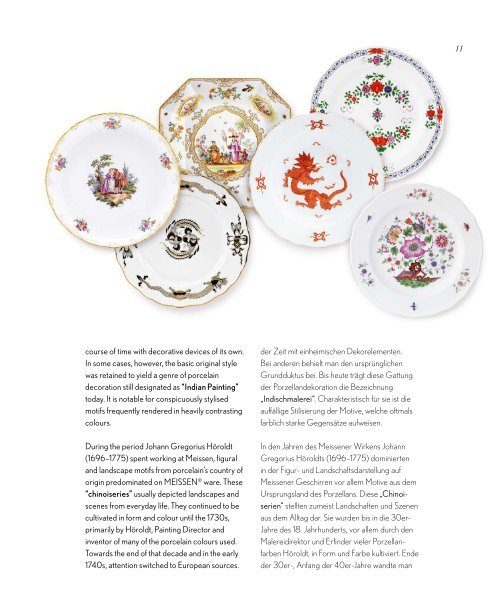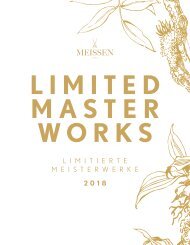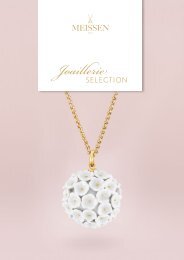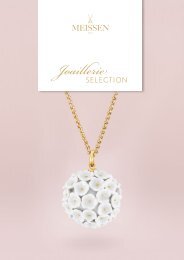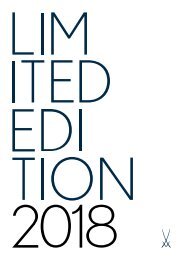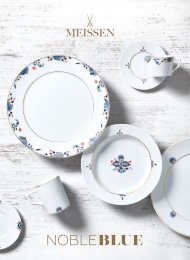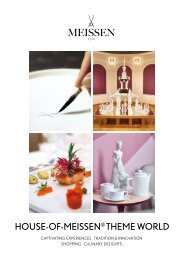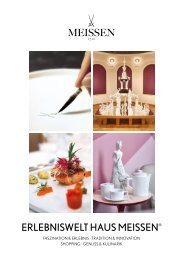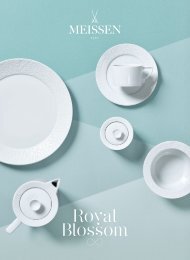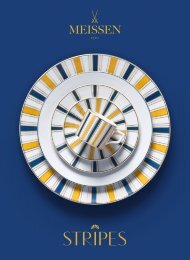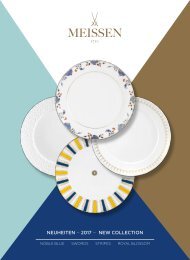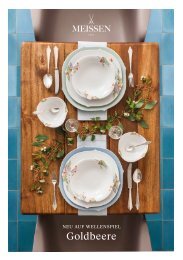MEISSEN Monkey Orchestra Asprey Edition
- No tags were found...
You also want an ePaper? Increase the reach of your titles
YUMPU automatically turns print PDFs into web optimized ePapers that Google loves.
11<br />
course of time with decorative devices of its own.<br />
In some cases, however, the basic original style<br />
was retained to yield a genre of porcelain<br />
decoration still designated as “Indian Painting”<br />
today. It is notable for conspicuously stylised<br />
motifs frequently rendered in heavily contrasting<br />
colours.<br />
During the period Johann Gregorius Höroldt<br />
(1696–1775) spent working at Meissen, figural<br />
and landscape motifs from porcelain’s country of<br />
origin predominated on <strong>MEISSEN</strong> ® ware. These<br />
“chinoiseries” usually depicted landscapes and<br />
scenes from everyday life. They continued to be<br />
cultivated in form and colour until the 1730s,<br />
primarily by Höroldt, Painting Director and<br />
inventor of many of the porcelain colours used.<br />
Towards the end of that decade and in the early<br />
1740s, attention switched to European sources.<br />
der Zeit mit einheimischen Dekorelementen.<br />
Bei anderen behielt man den ursprünglichen<br />
Grundduktus bei. Bis heute trägt diese Gattung<br />
der Porzellandekoration die Bezeichnung<br />
„Indischmalerei“. Charakteristisch für sie ist die<br />
auffällige Stilisierung der Motive, welche oftmals<br />
farblich starke Gegensätze aufweisen.<br />
In den Jahren des Meissener Wirkens Johann<br />
Gregorius Höroldts (1696–1775) dominierten<br />
in der Figur- und Landschaftsdarstellung auf<br />
Meissener Geschirren vor allem Motive aus dem<br />
Ursprungsland des Porzellans. Diese „Chinoiserien“<br />
stellten zumeist Landschaften und Szenen<br />
aus dem Alltag dar. Sie wurden bis in die 30er-<br />
Jahre des 18. Jahrhunderts, vor allem durch den<br />
Malereidirektor und Erfinder vieler Porzellanfarben<br />
Höroldt, in Form und Farbe kultiviert. Ende<br />
der 30er-, Anfang der 40er-Jahre wandte man


